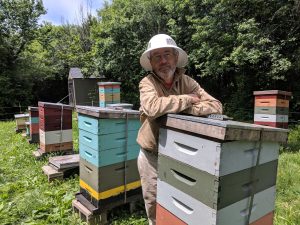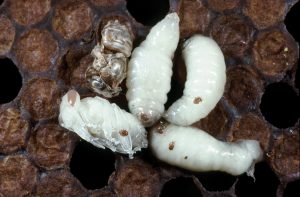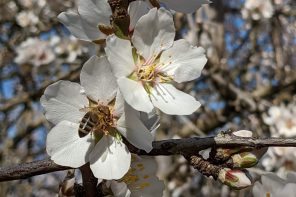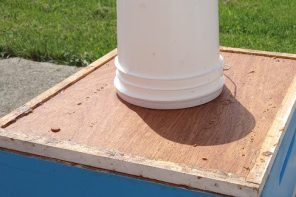Click Here if you listened. We’re trying to gauge interest so only one question is required; however, there is a spot for feedback!
Read along below!

Tropilaelaps
Is this mite really going to be worse than Varroa? Yes and no.
By: Ross Conrad
Our experience with Varroa has shown how much of a challenge dealing with mites can be. Trying to identify miticides that will not contaminate honey and wax, dealing with mites that develop resistance to our most toxic chemicals, relying on treatments that don’t always work due to weather or temperature issues, the list is long. This is part of the reason that scientists and others have long issued dire warnings should the Tropilaelaps mite ever make its way to European and American shores.
So far Tropilaelaps’ territory has been limited to its native Asia and bordering areas, and four distinct species of Tropilaelaps (T. careae, T. Koenigerum, T. mercedesae, T. Thaii) have been identified to date (Anderson and Morgan, 2007). Tropilaelaps careae and mercedesae are considered to be the most economically important since they are the primary mites that have jumped from their native giant honey bee hosts (Apis dorsata, Apis laboriosa, Apis breviligula) to the western honey bee (Apis mellifera) (de Guzman et al., 2017).
Like varroa destructor, which is also indigenous to Asia, mature Tropilaelaps mites are a reddish-brown color and although the mite is smaller in size (about a third of the size of a varroa mite), the life cycle of Tropilaelaps is similar to that of varroa. Adult female mites enter cells containing older larvae, are sealed in the cells when the workers cap the brood and produce offspring that feed on the developing honey bee pupae. Like honey bees, fertilized eggs develop into female mites and unfertilized eggs produce males. Just like with varroa, the female offspring of a single Tropilaelaps mite are able to mate with their brothers and initiate an infestation. Tropilaelaps moves much quicker than Varroa, reproduces faster than varroa laying eggs in quicker succession and has a much shorter phoretic stage where the mite exists outside the brood cell. While varroa are known to create a single wound and repeatedly visit the site to feed, Tropilaelaps mites create multiple small wounds from which they feed. Unfortunately, just like varroa, Tropilaelaps is known to vector honey bee viruses like Deformed Wing Virus. Tropilaelaps can also spread naturally within a colony, between colonies in the same apiary and among apiaries via hitching a ride on robbing workers or drifting drones (Rath et al., 1991).

Although smaller than a varroa mite, the Tropilaelaps mite is visible to the naked eye and moves much more rapidly than their varroa cousins.
Tropilaelaps also have a severe weakness, the mites are not able to easily feed on mature bees apparently due to the inability of their mouthparts to pierce the hard cuticle layer of adults. While there are some soft areas on an adult bee that the mite could take advantage of, such as at the base of the wings, it is unusual to find Tropilaelaps feeding on adult honey bees. Tropilaelaps primarily feed on the soft-bodied larvae and pupae and must do so regularly or they will die after two to three days. Without a constant supply of larvae and pupae, Tropilaelaps is unable to maintain its rapid reproduction rate and stay alive. This means that in northern climates where honey bees experience a natural period of prolonged brood interruption due to the dearth of Winter, a brood break that is known to severely reduce varroa populations, can also be expected to impact Tropilaelaps in a similar manner, although the mite’s establishment in the temperate regions of South Korea and northern China suggests that a minority of mites (about 15%) are able to somehow adapt to such broodless periods (de Guzman et al., 2017). This may help give northern beekeepers an edge on dealing with Tropilaelaps compared to southern beekeepers whose colonies are unlikely to stop all brood production during the season unless exposed to drought conditions. This also means that swarming, which is known to reduce varroa populations in colonies, can also be expected to reduce Tropilaelaps populations. Also, starting a colony without brood such as through a package of bees is a great way to ensure a colony is Tropilaelaps-free, at least during its initial startup phase.
Another reason to think that Tropilaelaps will not be a major catastrophe for American beekeepers should the mite arrive in North America is by observing the experience of Chinese beekeepers who have been dealing with Tropilaelaps for decades and continue to be the largest producer of honey in the world. Chinese beekeepers are reportedly able to control Tropilaelaps with sublimated sulfur. Additionally, there is evidence that many of the currently approved varroa treatments available in the U.S. are also effective against Tropilaelaps. Current approved varroa mite treatments that have been shown to also reduce Tropilaelaps infestations include formic acid fumigation, Amitraz and fluvalinate (Webster & Delaplane, 2001), Hopguard® and Mite-Away Quick Strips (Pettis, 2017) and formic acid and thymol (Raffique et al., 2012).
As in the case of Varroa Sensitive Hygiene (VSH) where bees are able to detect when varroa are feeding on capped brood, worker bees appear able to detect brood cells parasitized by Tropilaelaps, and have been known to uncap and remove infested pupae (Webster & Delaplane, 2001).
As mentioned before, Tropilaelaps mites need larvae and pupae to feed on or they will die after two to three days. This suggests that bio-mechanical controls such as caging the queen periodically and depriving the colony of brood can keep Tropilaelaps mites at bay by beekeepers that do not wish to use pesticides on their colonies. Another easy way to take advantage of this Achilles heel is to simply divide the colony, moving all brood combs and adhering bees into a new box and leaving the queen and broodless combs and bees in the original hive. The queenless colony will begin rearing a new queen, but the resulting interruption in brood production will kill off all the Tropilaelaps mites. Meanwhile, the mites will also all die out in the queenright half of the hive since there will be no brood to feed on and it will be approximately three days before any new eggs the queen lays can hatch and form larvae that the mites need for food. If this process is carried out at the end of the nectar flow, no honey production need be sacrificed and colony numbers can either be expanded by keeping the newly created hives or hive populations can be maintained by recombining the colonies.
Due to their short phoretic phase, traditional varroa detection methods such as the sugar shake or alcohol wash, are ineffective in detecting Tropilaelaps. Instead, beekeepers will have to rely upon brood uncapping, bump testing, sticky board inspection and thorough colony inspections. Tell-tale signs of Tropilaelaps infestation are irregular brood patterns and perforated brood cappings caused by sanitary behavior of the bees. Similar to hives heavily infested with varroa, adults in colonies heavily infested with Tropilaelaps are likely to have stunted abdomens, deformed wings and exhibit parasitic mite syndrome symptoms. It is commonly reported that heavily infested colonies will abscond from their hive.
When varroa first arrived, American beekeepers didn’t know much about the mite’s biology and we didn’t have any approved treatments available. We were basically starting from square one. With Tropilaelaps, things are much different and therefore should the mite appear in American beeyards, there is every reason to expect a much less destructive and disruptive experience for most beekeepers. Good news is not easy to come by these days so we should take it wherever we can find it.
Ross Conrad is author of Natural Beekeeping, Revised and Expanded 2nd edition and The Land of Milk and Honey: A history of beekeeping in Vermont. Ross will be teaching a beginner beekeeping class the weekend of May 20-21, 2023 and an intermediate class on June 4, 2023. For more information or to register for either class visit dancingbeegardens.com
References:
Anderson, D. L. and Morgan, M. J. (2007) Genetic and morphological variation of bee parasitic tropilaelaps mites (Acari: Laelapidae): New and re-defined species, Exp. Appl. Acarol, 43:1-24
De Guzman, L.I., Williams, G.R., Khongphinitbunjong, K., Chantawannakul, P. (2017) Ecology, Life History, and Management of Tropilaelaps Mites, Journal of Economic Entomology, 110(2):319-332
Petis, J.S., Rose, R., Chaimanee, V. (2017) Chemical and cultural control of Tropilaelaps mercedesae mites in honey bee (Apis mellifera) colonies in Northern Thailand, PLOS ONE
Raffique, M.K., Mahmood, R., Aslam, M., Sarwar, G. (2012) Control of Tropilaelaps clareae mite by using formic acid and thymol in honey bee Apis mellifera L. colonies, Pakistan Journal of Zoology, 44(4): 1129-1135
Rath, W., Delfinado-Baker, M., Drescher, W. (1991) Observations on the mating behavior, sex ratio, phoresy and dispersal of Tropilaelaps clareae (Acari: Laelapidae), International Journal of Acarology, 17(3): 201-208.
Webster, Thomas C. and Delaplane, Keith S. (2001) Mites of the Honey Bee, Dadant & Sons, Hamilton, IL
Woyke, J. (1985) Further investigations into control of the parasitic bee mite Tropilaelaps clareae without medication, Journal of Apicultural Research, 24(4): 250-254








